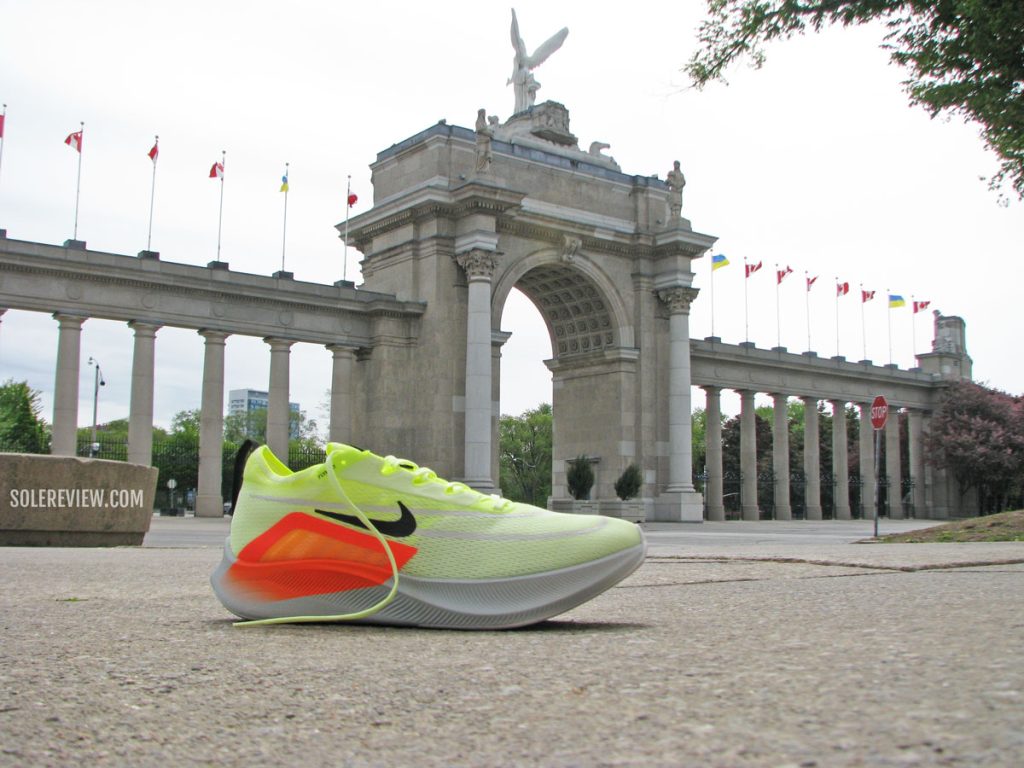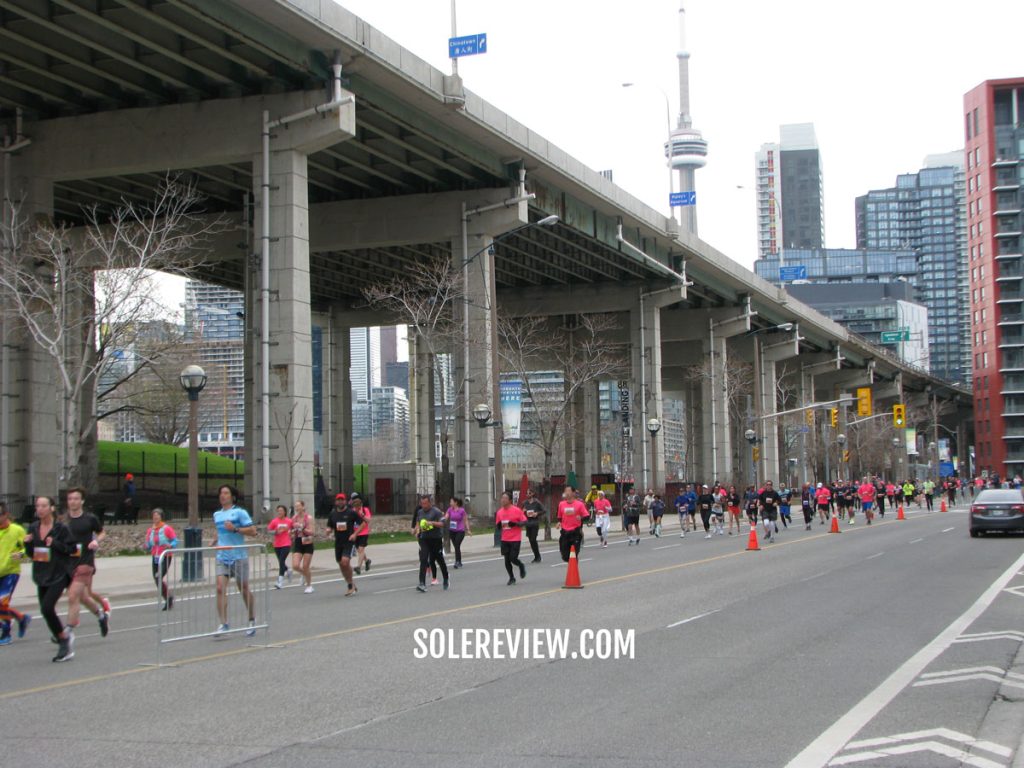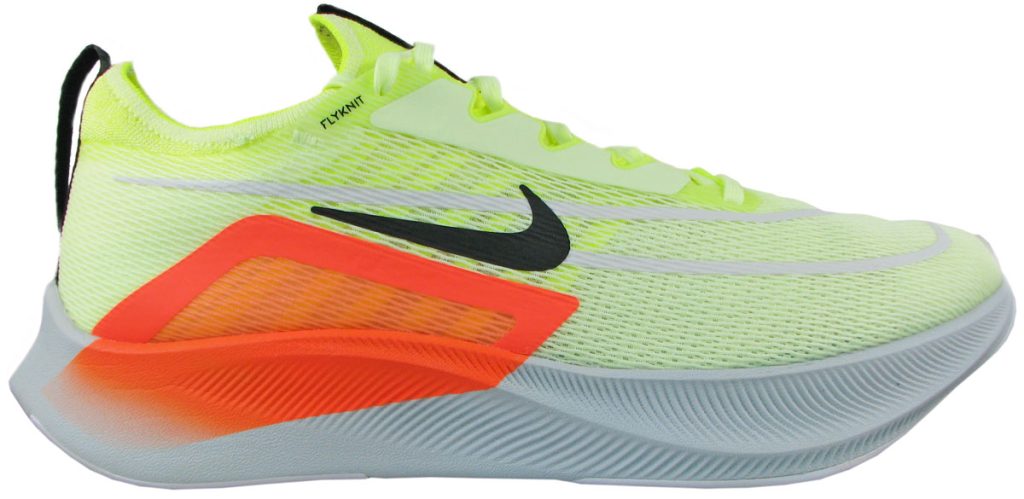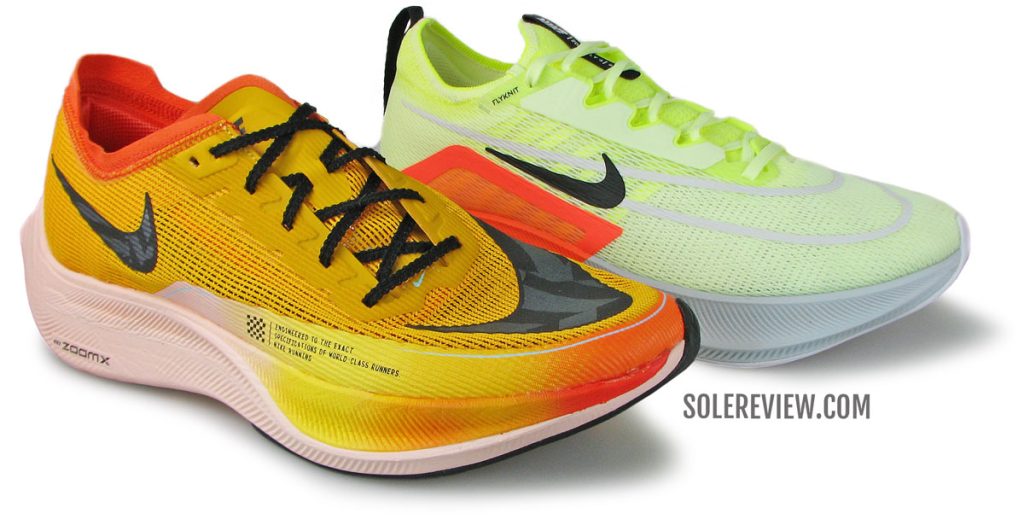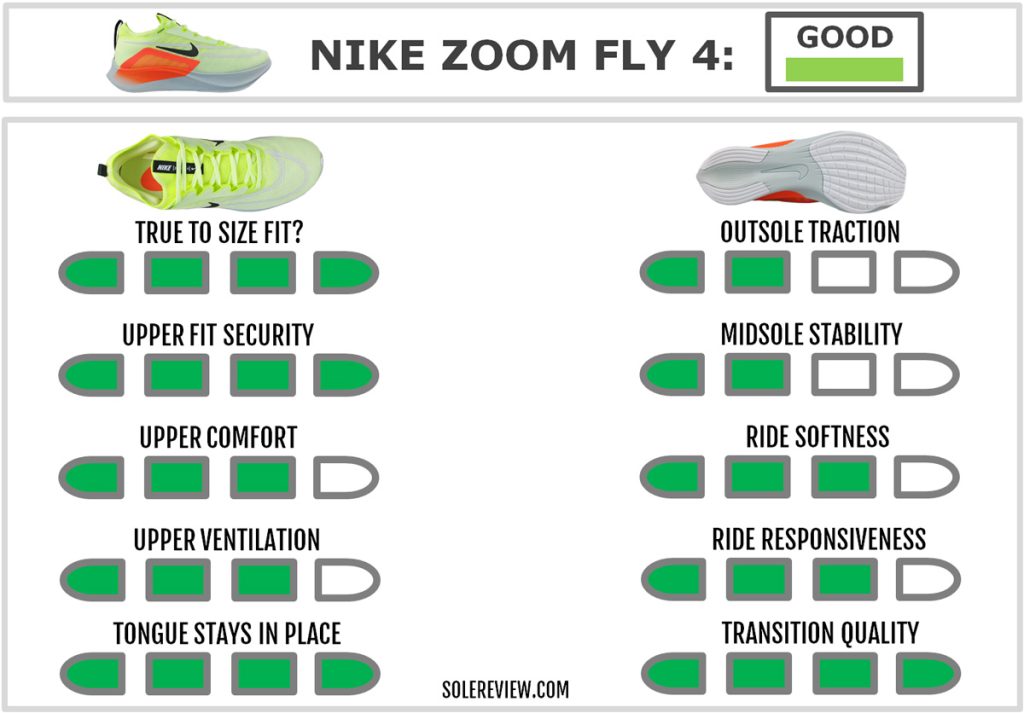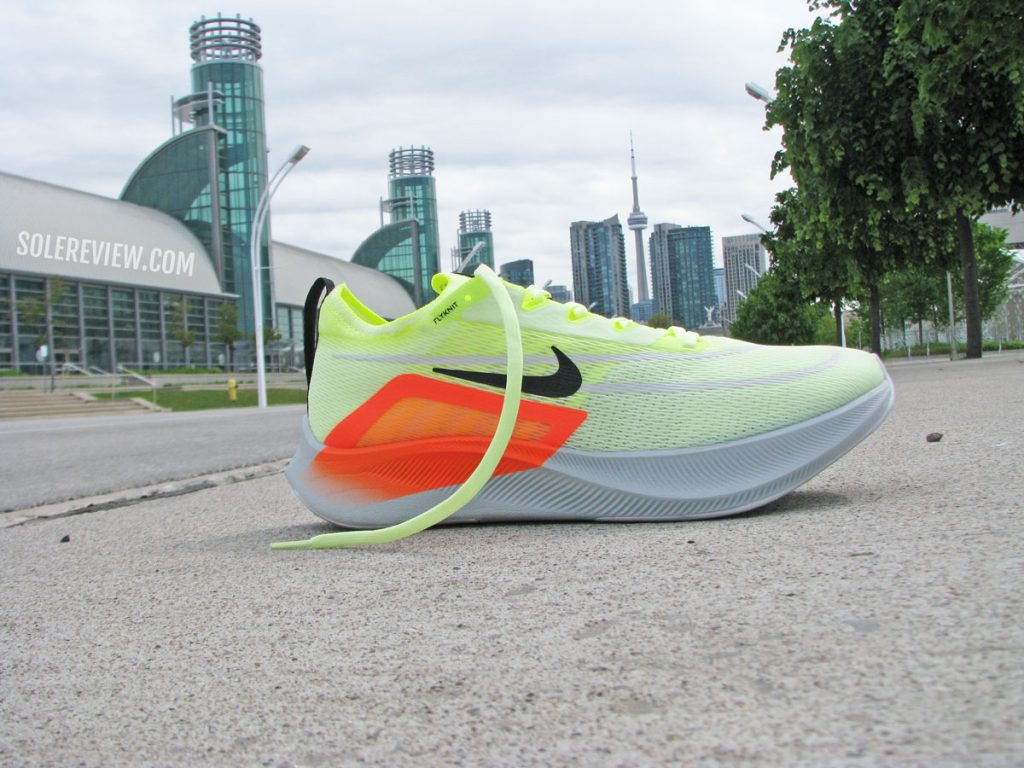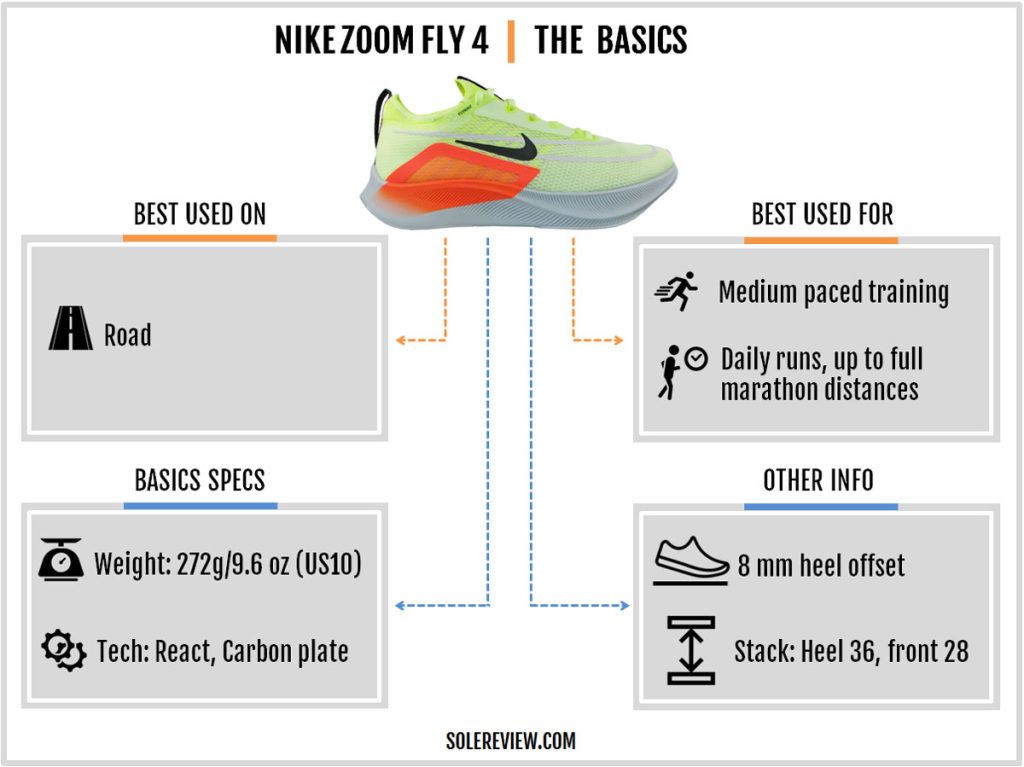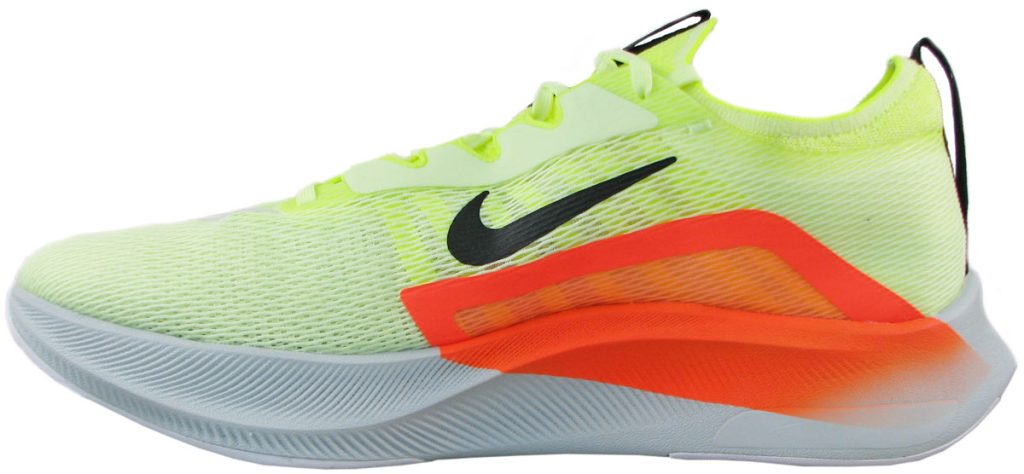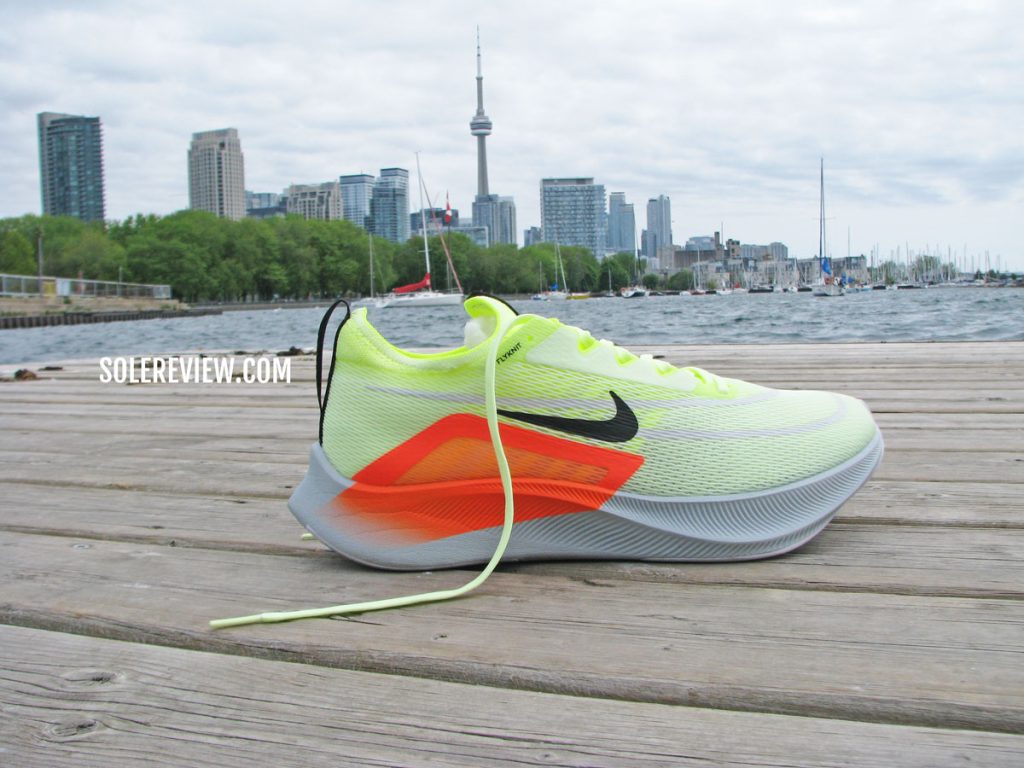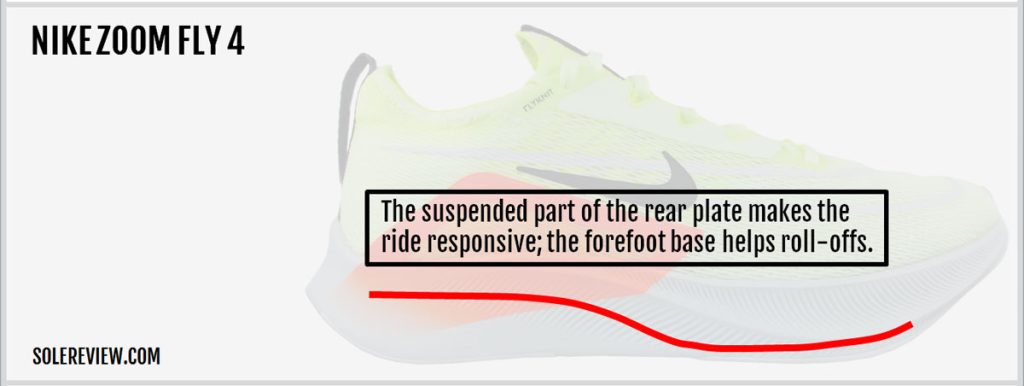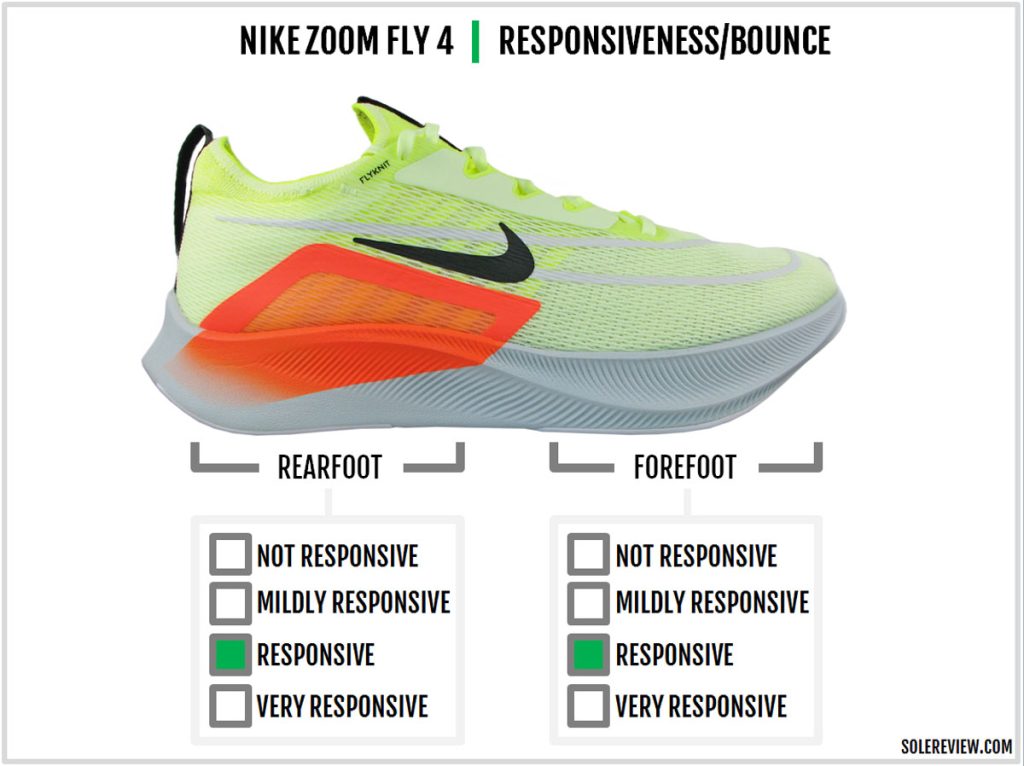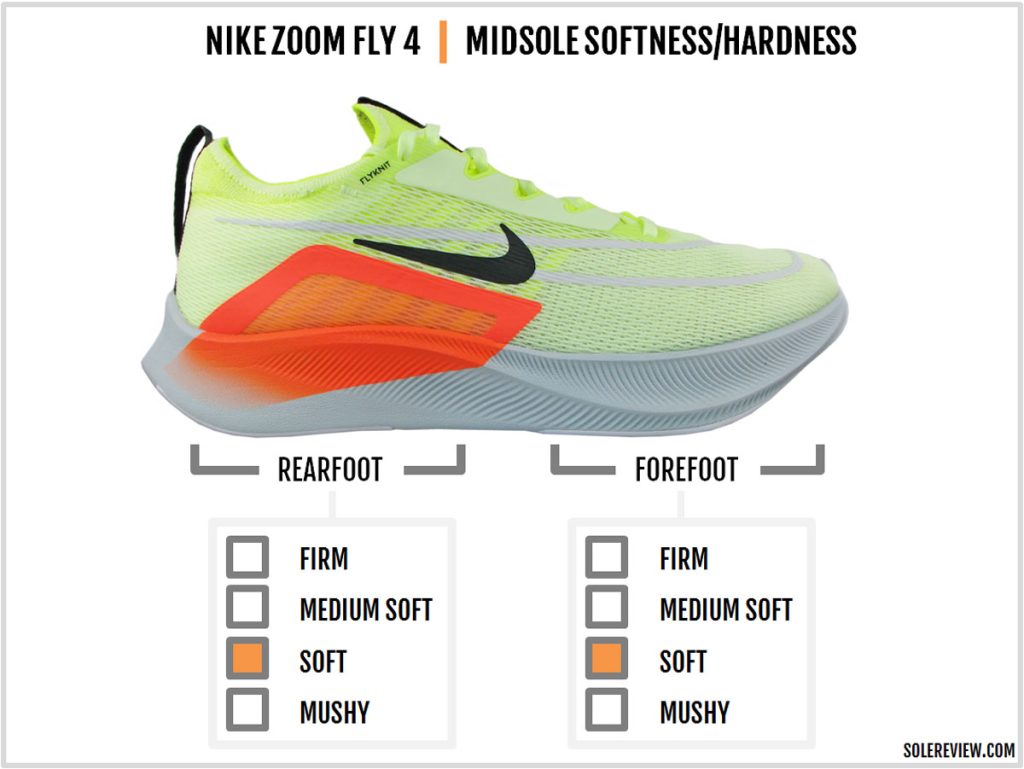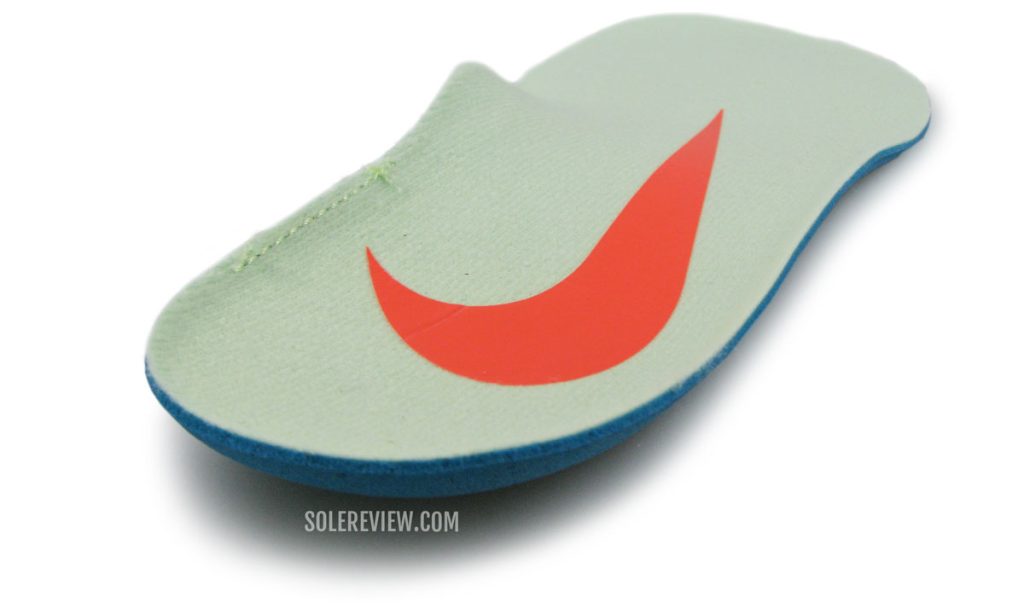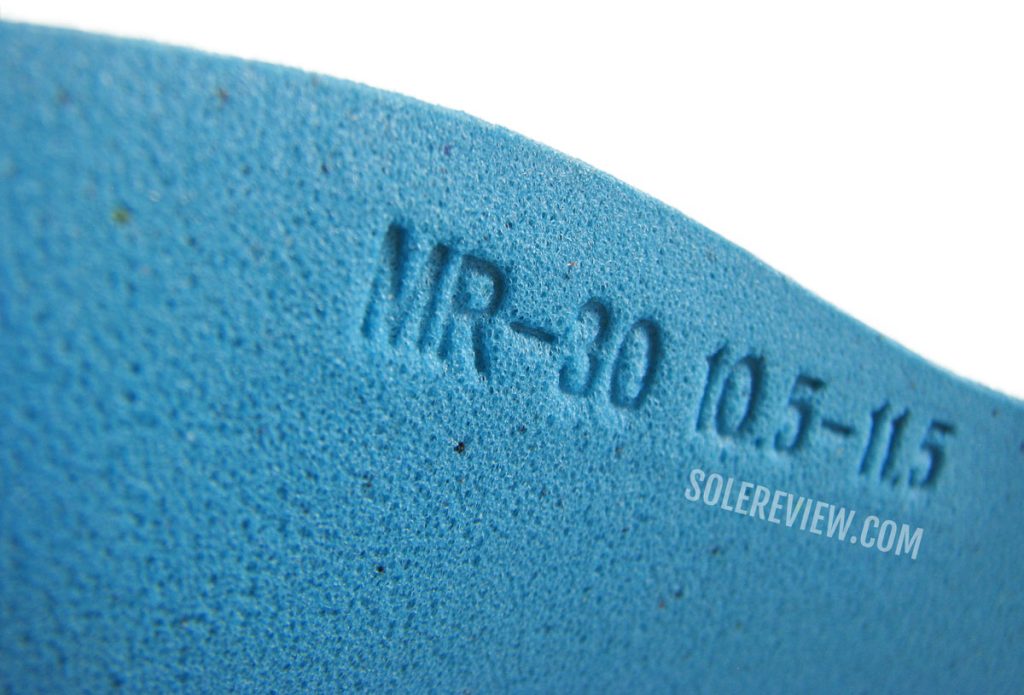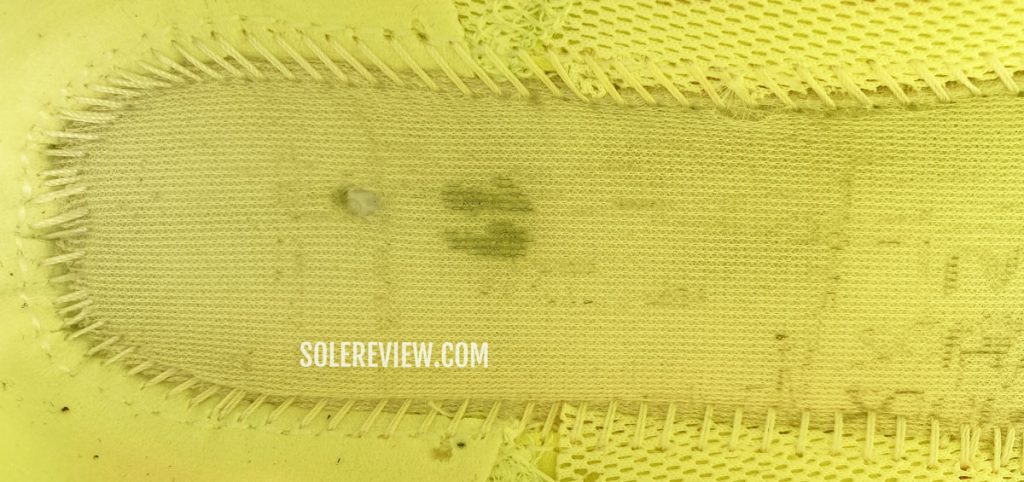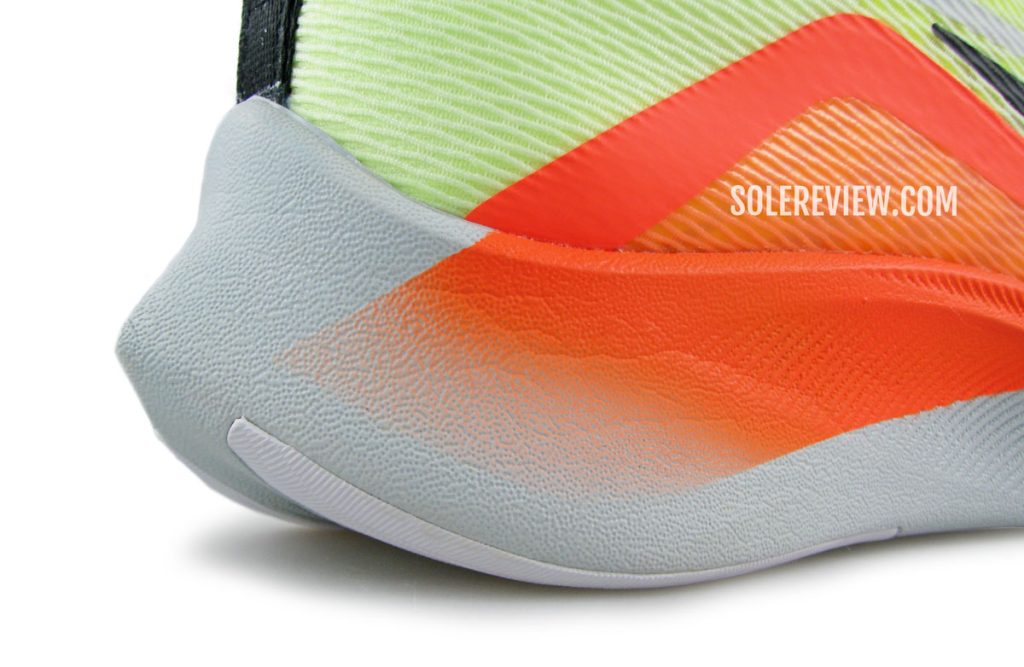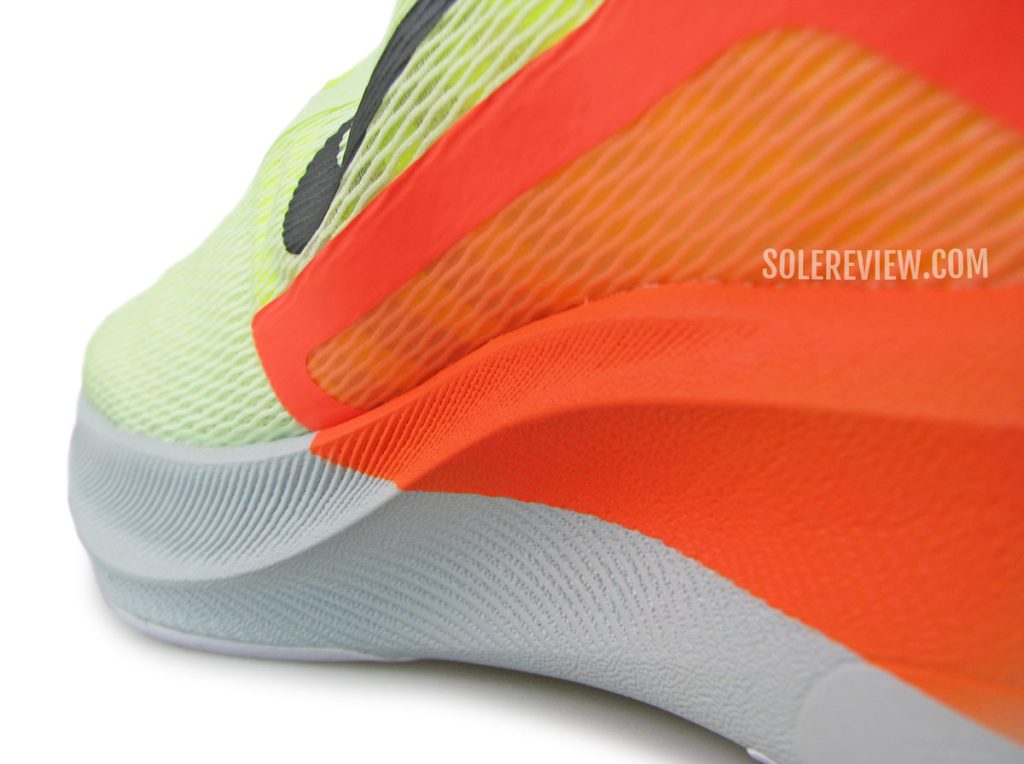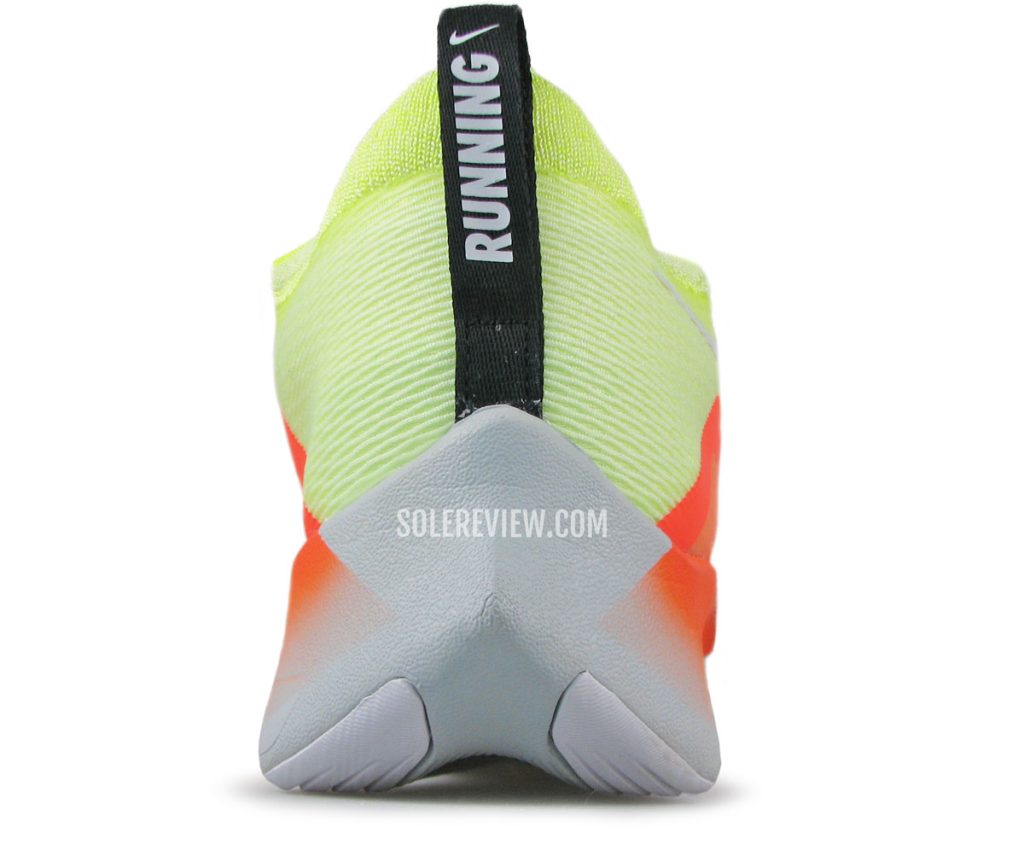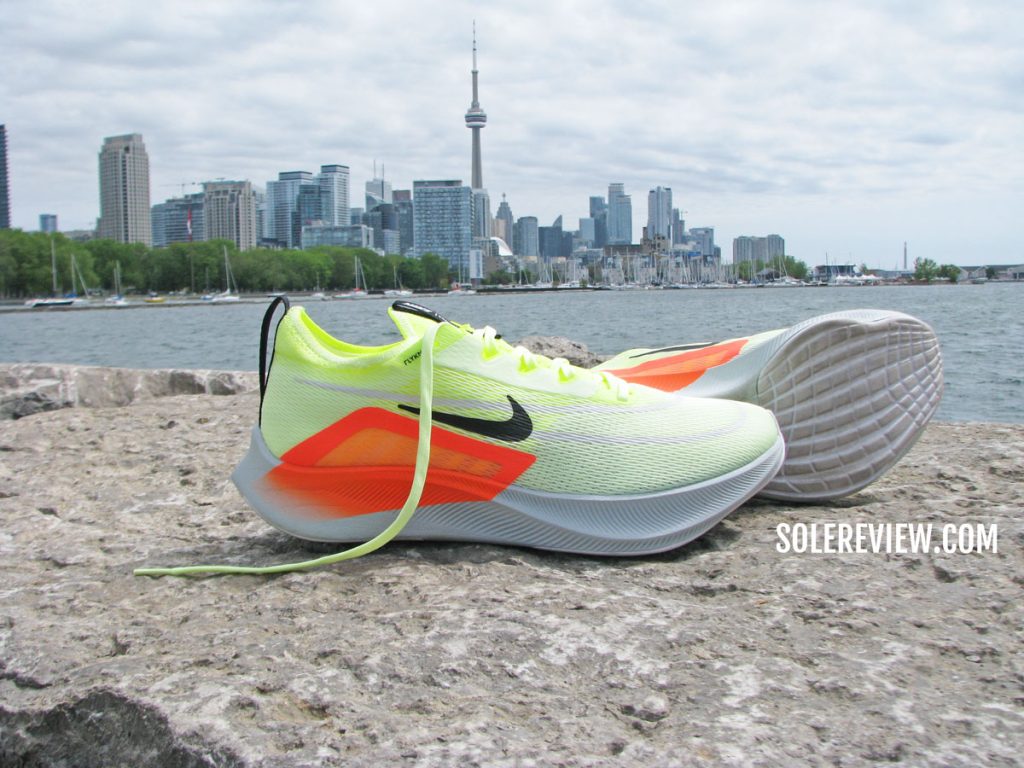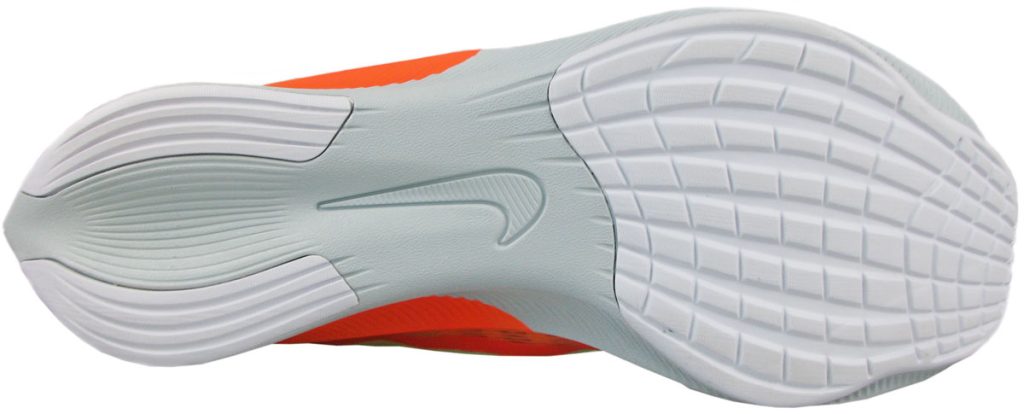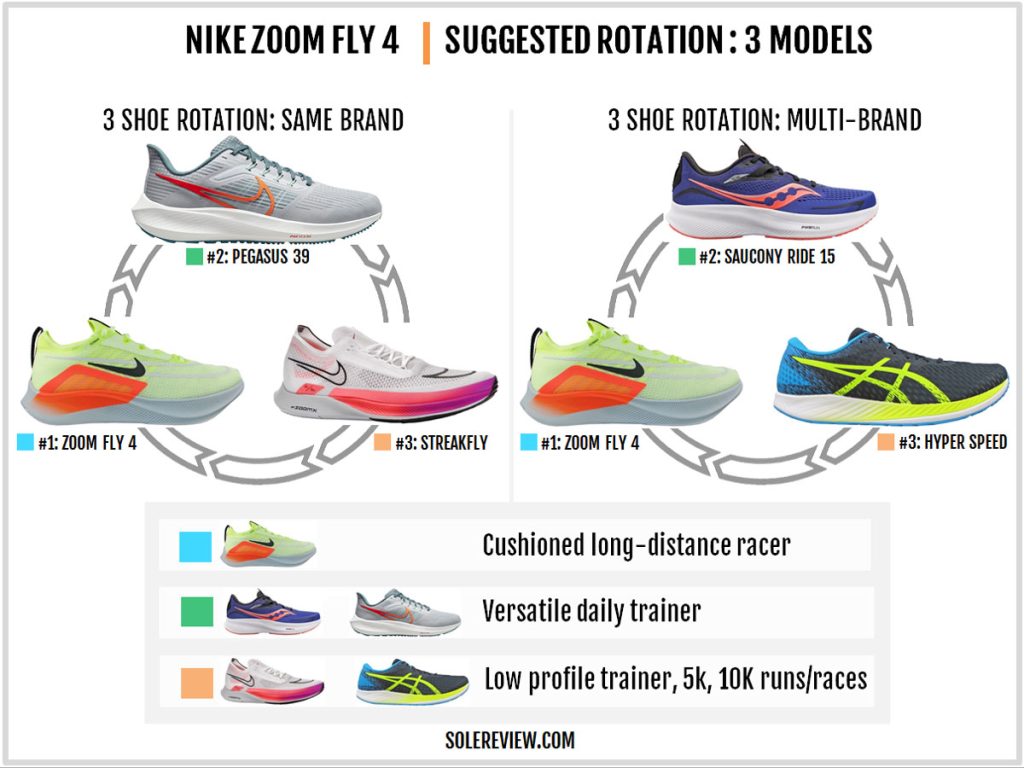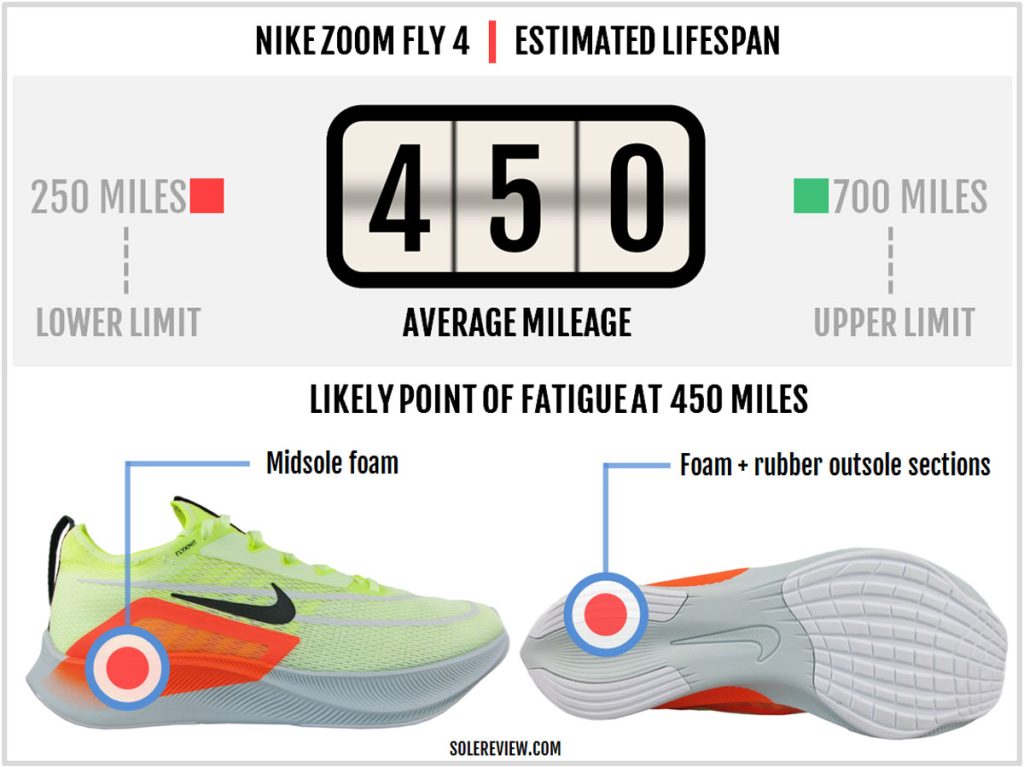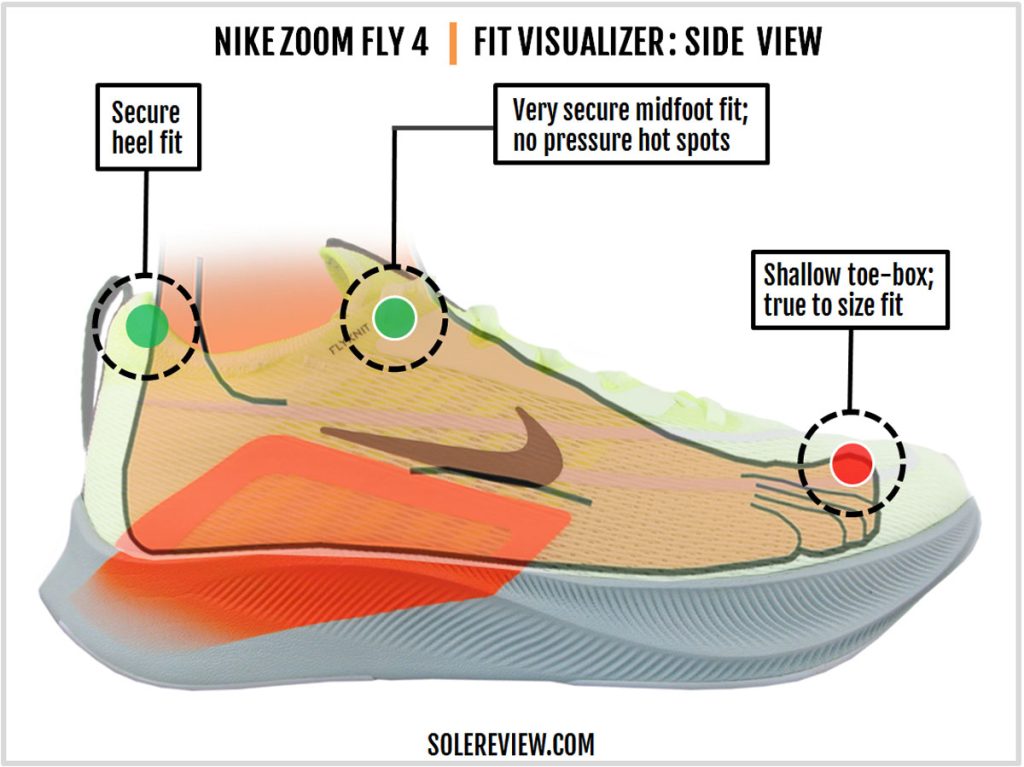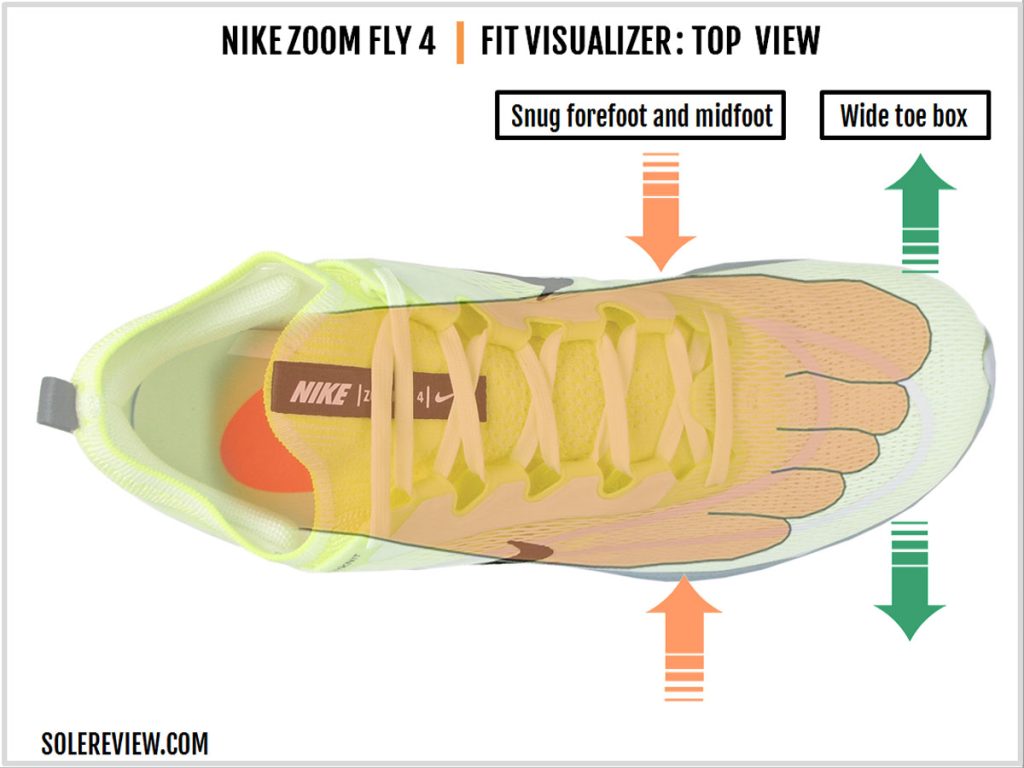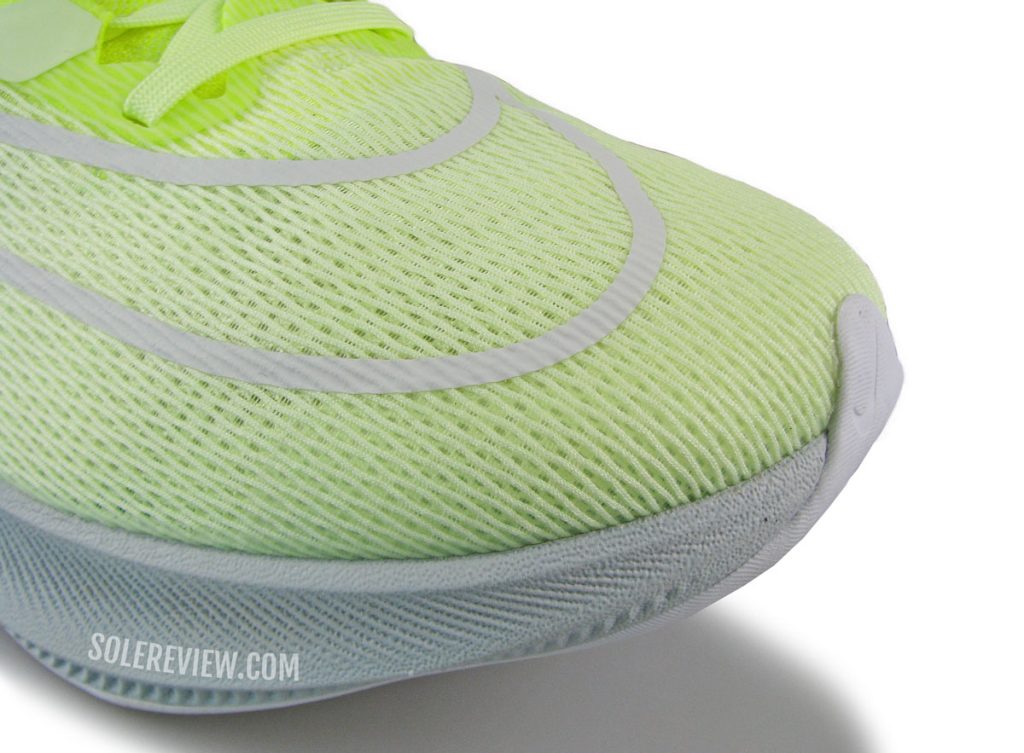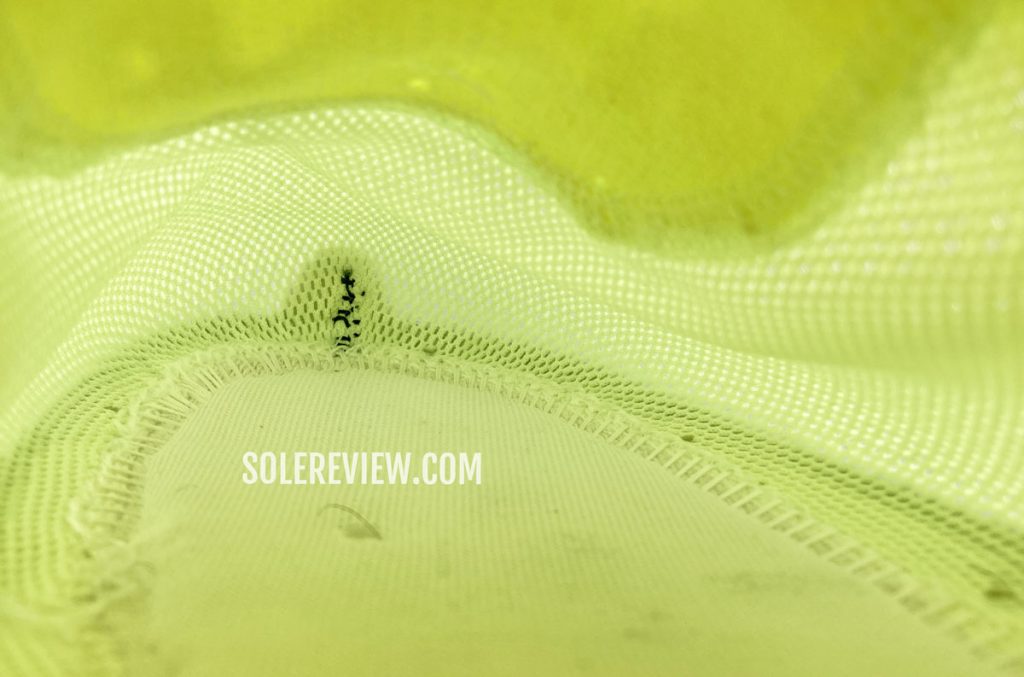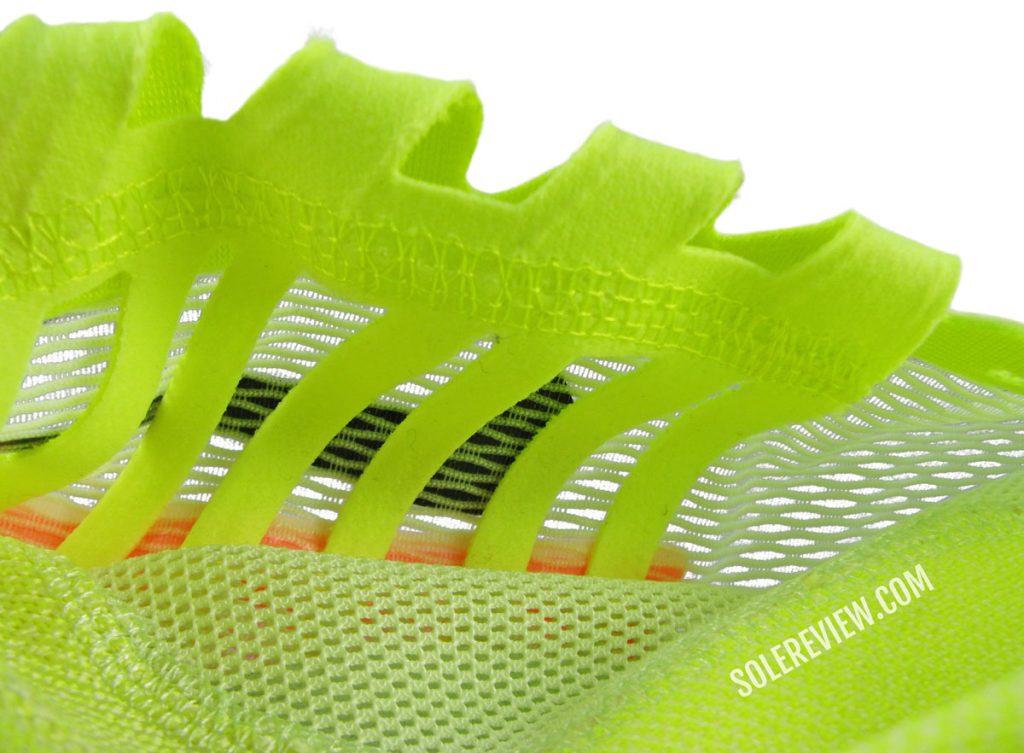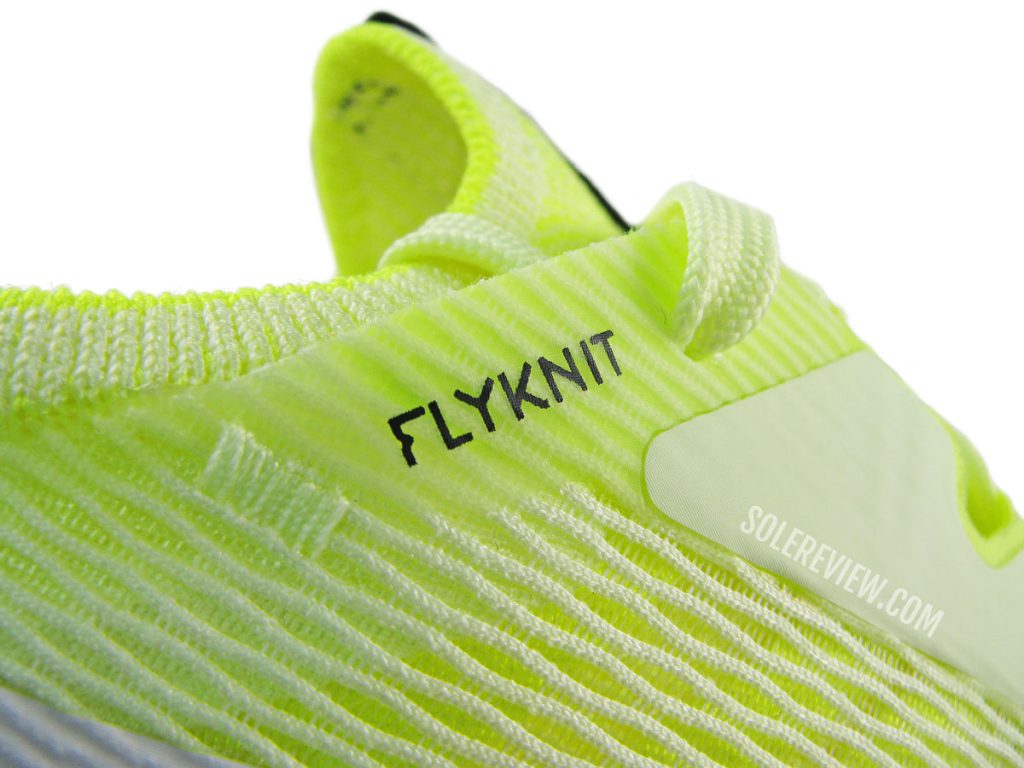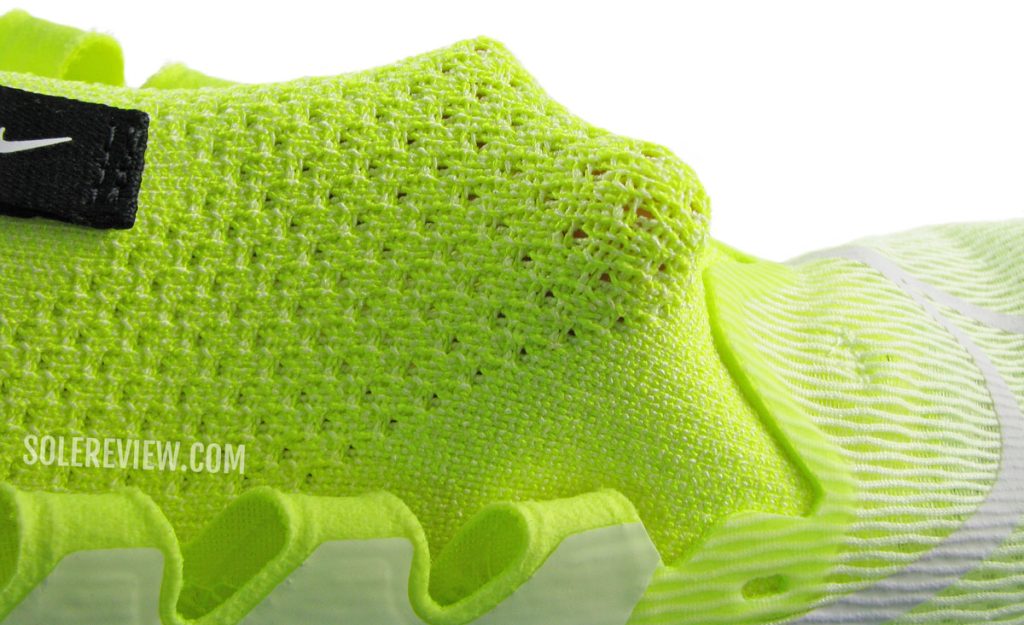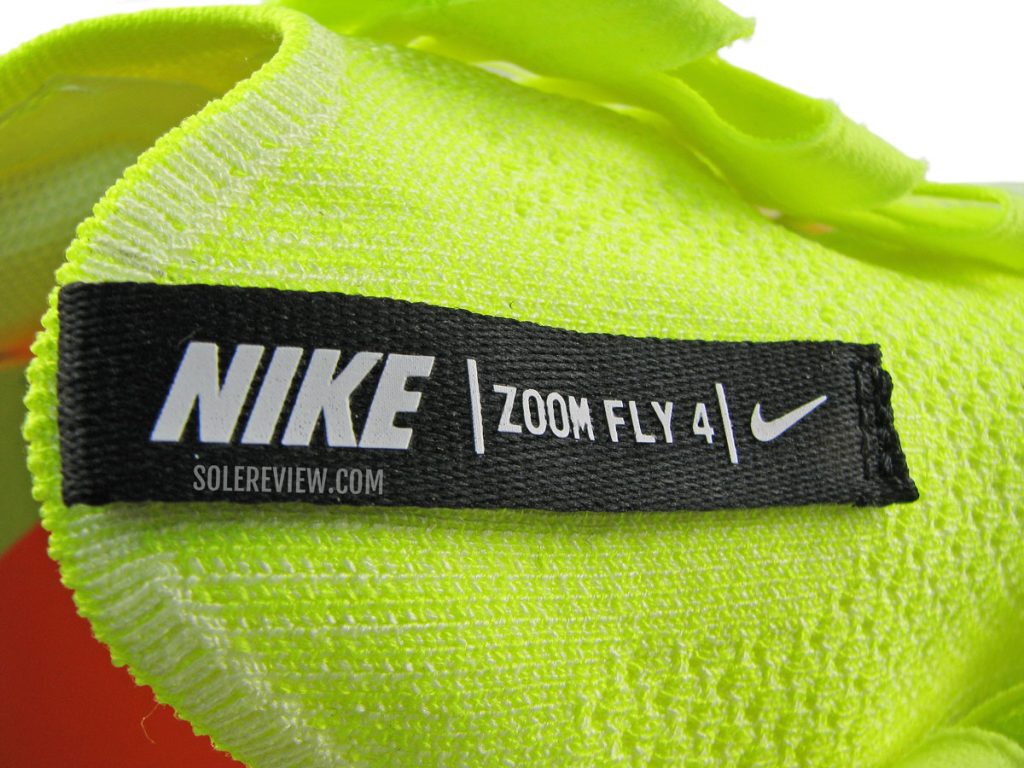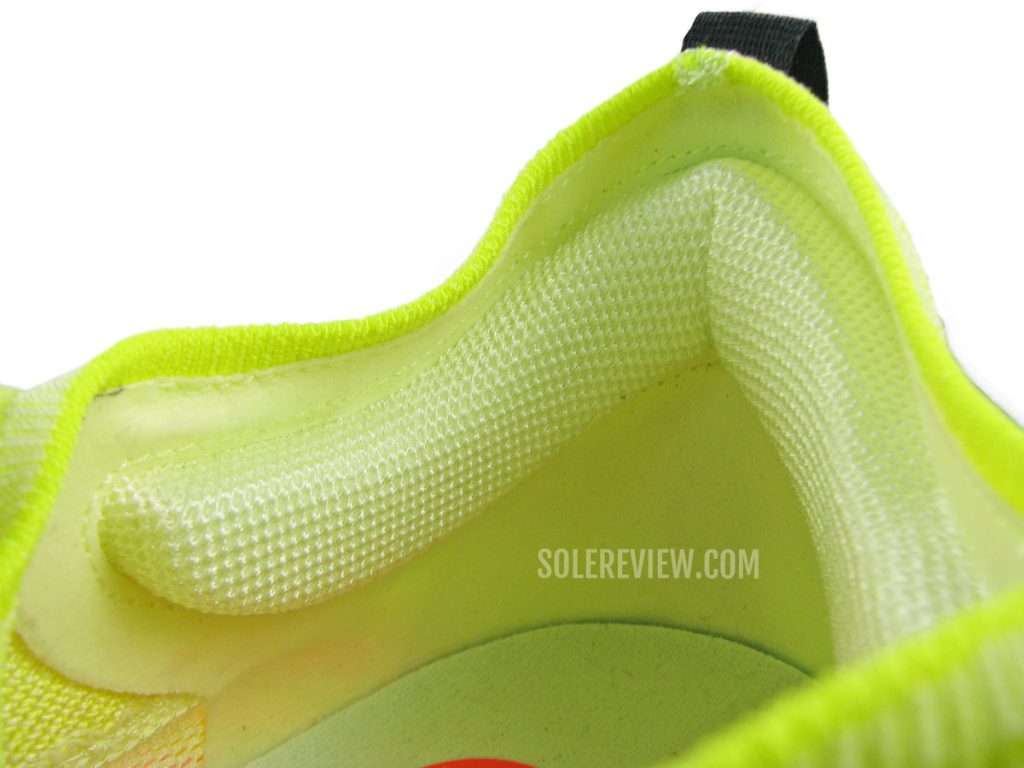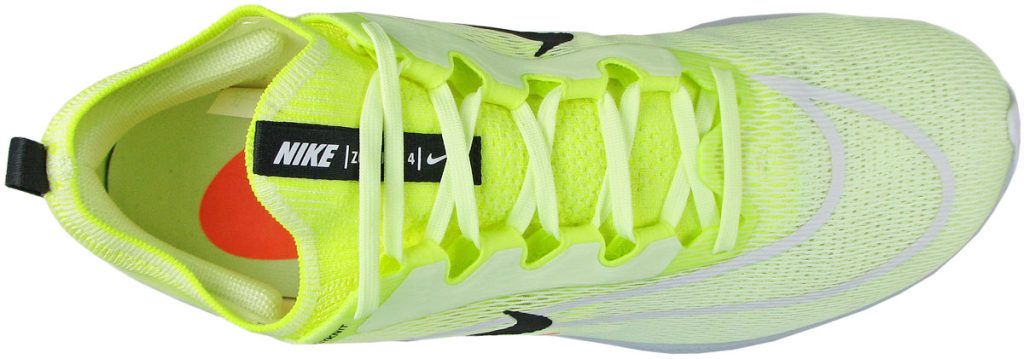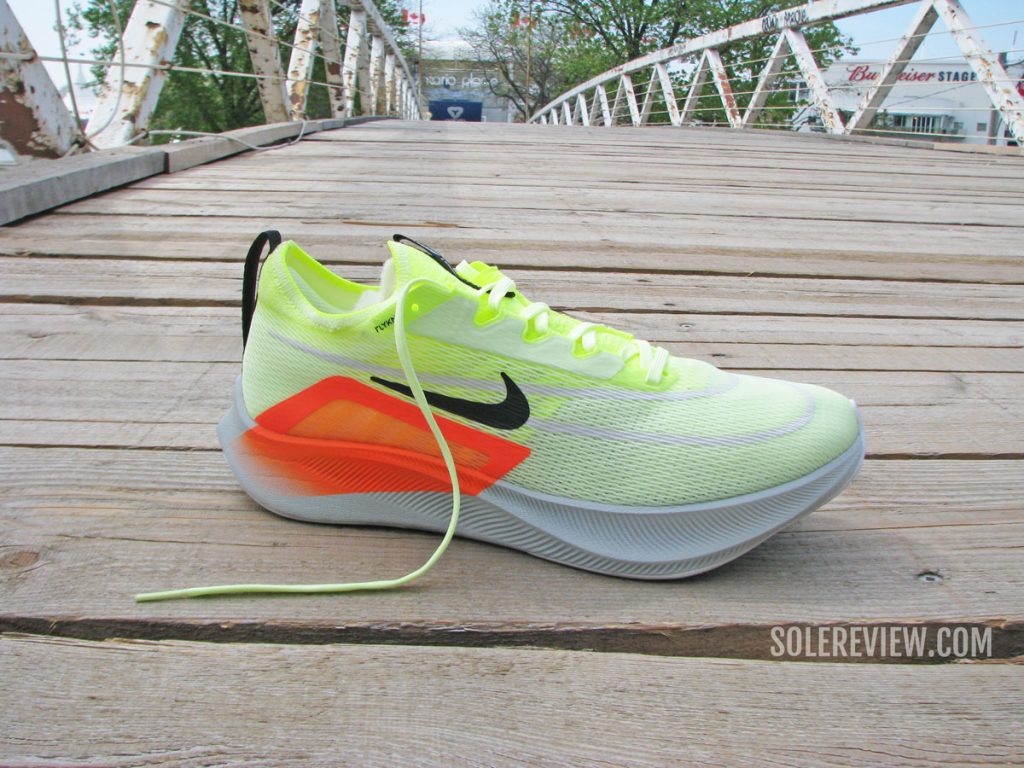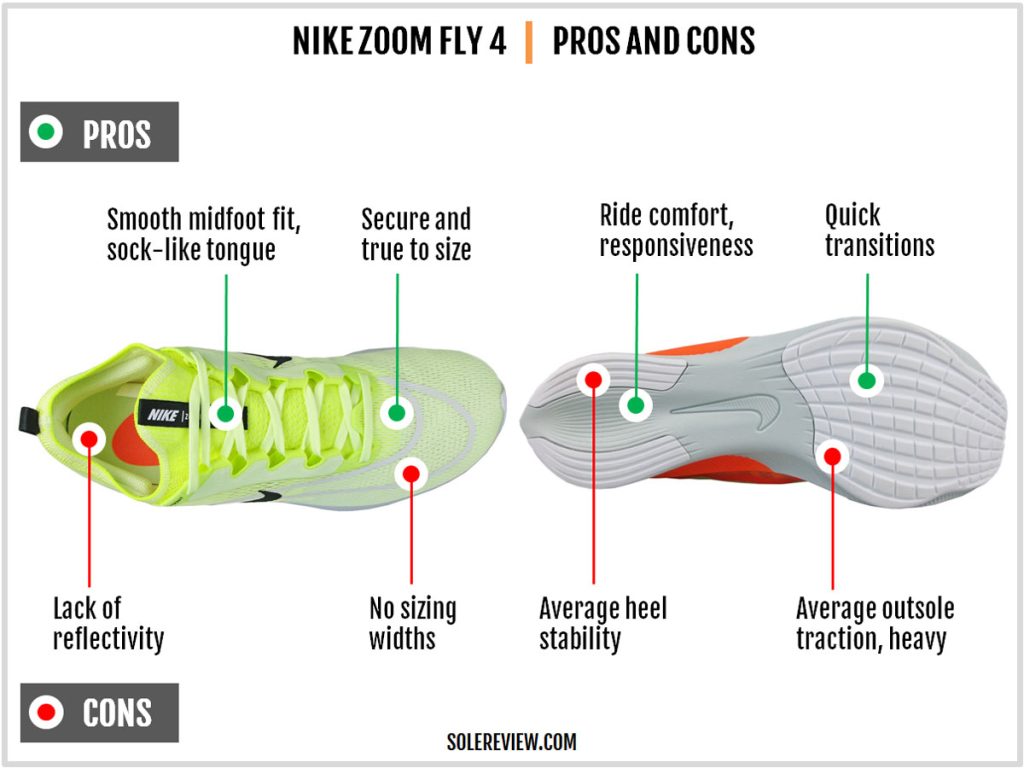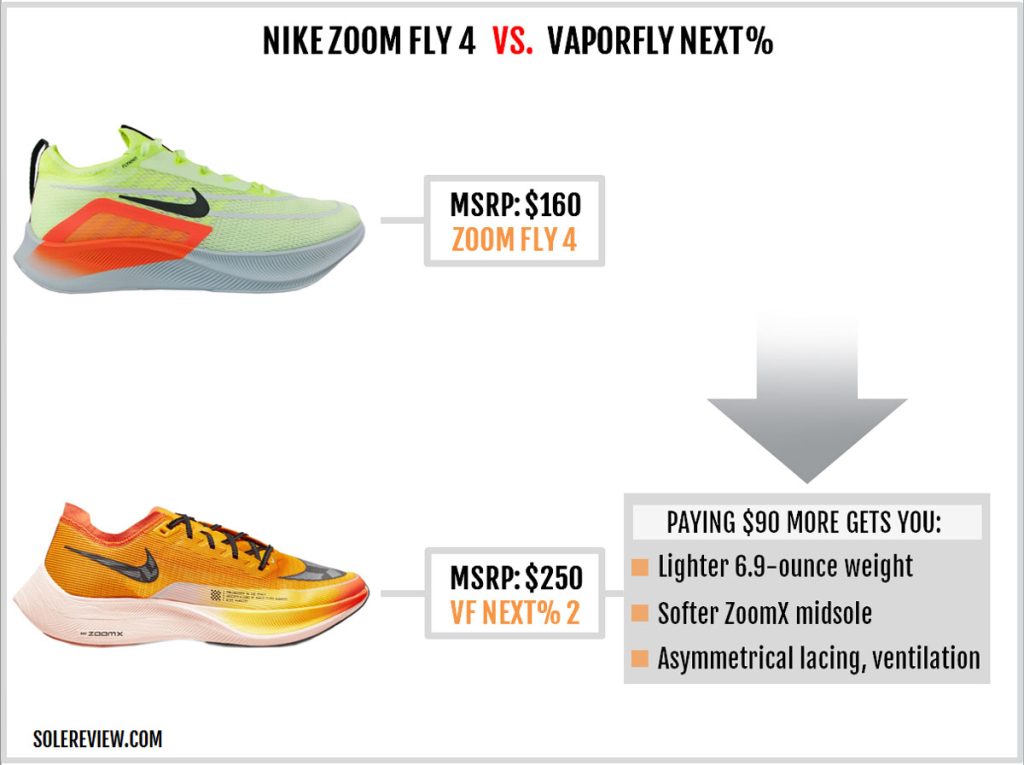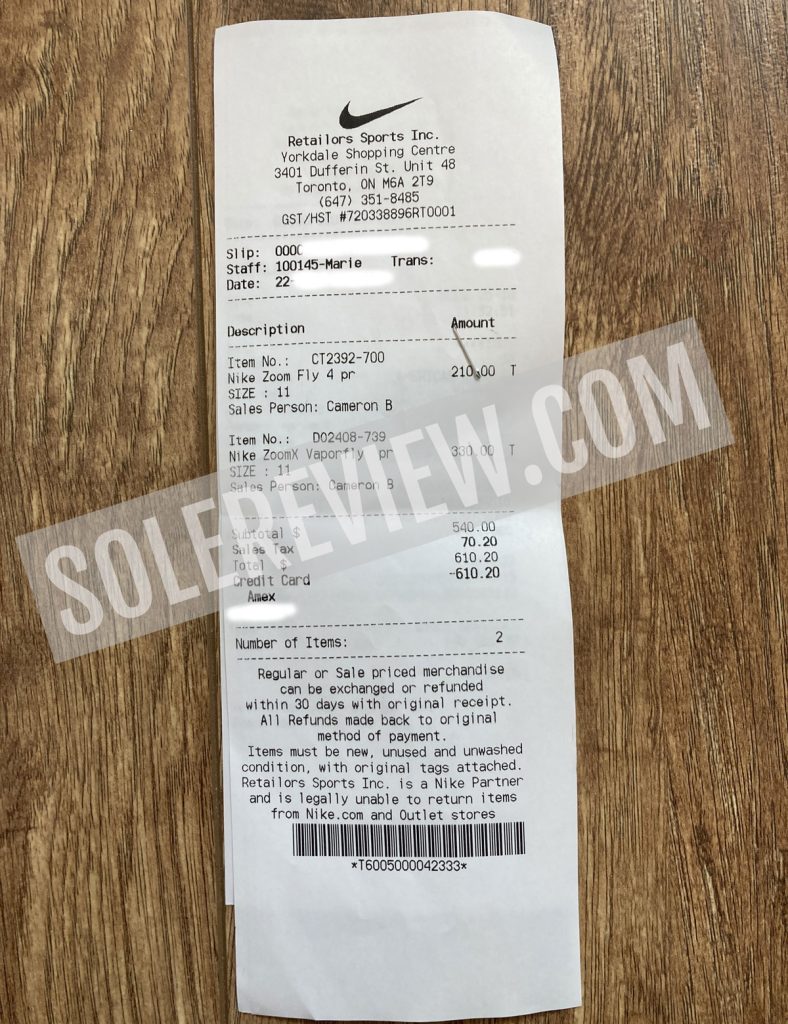
The Nike Zoom Fly 4 was purchased at full retail price for our review. The amount is in Canadian Dollars.
In this review:
INTRODUCTION
We recently did a shoe count at the Toronto Marathon, and the sightings of the Nike Vaporfly Next% 2 vastly outnumbered the Nike Zoom Fly 4. For every thirty runners wearing the Vaporfly, we saw just a single runner wearing the less expensive Fly 4. Heck, even the Alphafly seemed to be more popular than the Fly.
That makes sense, given the huge performance gap between the two models.
The Next% is nearly 3-ounces lighter than the Zoom Fly, all while offering a softer and more responsive ride – courtesy of the ZoomX foam midsole. The see-thru mesh upper of the Vaporfly Next% breathes much better than the sleeved Zoom Fly, and that keeps the insides cool during long-distance runs.
Here’s an interesting bit of trivia. When you flip the digits of the Zoom Fly 4’s 9.6-ounce weight, you get 6.9-ounces – which is what the Vaporfly weighs.
The Next%’s much softer midsole also delivers the unadulterated Carbon plate experience; the snap is very noticeable. Whereas on the Zoom Fly 4, the plate-induced spring is very subdued. It’s not even a contest; the running in the Vaporfly is a very engaging experience.
It was apparent that many runners found the Vaporfly’s additional performance benefits to be well worth the $90 price premium.
Solereview doesn’t disagree either. If given a choice, we’d also put our money on team Vaporfly as a marathon-worthy pick.
However, very few people run a marathon every week.
So if one had to choose between the Vaporfly Next% 2 and Nike Zoom Fly 4 as an everyday running shoe, the Zoom Fly 4 makes a strong case for itself.
The Zoom Fly 4 is like a Nike Pegasus, but with a quicker ride, more cushioning, and slightly lower versatility.
Like the popular neutral trainer, the Zoom Fly 4 has a ride quality that works for several use cases. The combined cushioning of the React foam and Carbon plate offers a high level of ride comfort and speed-friendly responsiveness.
Naturally, ‘everyday runs’ are in a relative sense to the Vaporfly Next%. For example, the Zoom Fly 4 isn’t cut out for certain kinds of runs.
For example, track sprints, short 5K races, and off-road trail use aren’t suitable for the Fly. It is also a better shoe for slightly higher paces (ideally over 5 min/km, 8 min/mile) than slow cruising.
Also, the heavier build has a performance advantage over the Next % and other PEBA-based racers like the Saucony Endorphin Speed and Pro. The dense midsole of the Zoom Fly 4 doesn’t have as much ‘give’ as a PEBA midsole.
When combined with the layered upper, the React foam stack makes the Fly 4 a durable running shoe, as the midsole is less likely to undergo deep creasing that’s often seen on the Vaporfly.
Even though the Zoom Fly 4 is based on the same midsole as the Fly 3, we like the V4 better. Switching the mesh material from the fancy Vaporweave to two layers of breathable mesh improves interior comfort. The updated midfoot strapping system also creates a smoother fit experience.
Despite the identical chassis, the ride also feels softer than the Zoom Fly 3. However, that’s not uncommon. We’ve reviewed many running shoes that tweaked the midsole formulation to make the cushioning softer.
What’s interesting, however, is that the Zoom Fly 4’s softer cushioning doesn’t appear to be a case of softer foam but rather the redesigned upper.
Intrigued? As with all our in-depth reviews, this page offers a detailed breakdown of the ride and fit character.
THE MIDSOLE DESIGN AND RIDE EXPERIENCE
This is the only Nike shoe without ZoomX or Zoom Air, but calls itself Zoom Fly. Here, the term ‘Zoom’ is used as a verb instead of a noun – as in, go fast kind of Zoom.
Before the Carbon-plated Zoom Fly showed up in 2017, Nike sold another 2014 shoe by the same name. We reviewed that shoe eight years ago, but at least that shoe had a forefoot Zoom Air bag.
The Zoom Fly 4’s midsole is made of React foam – a cushioning material that’s denser and firmer than the PEBA-based ZoomX that’s used on the Vaporfly.
React also happens to be significantly heavier, so that translates into a 9.6-ounce weight for a half pair of US size 10. That puts the Zoom Fly 4 in the ‘regular trainer’ weight class instead of the group that has shoes like the 7-ounce Vaporfly and Saucony Endorphin Pro.
Speaking of the plate, the React midsole has the same full-length Carbon plate that’s housed inside the Vaporfly. However, the plate’s behavior differs from the Vaporfly in a couple of ways.
Since the plate lives inside a firmer midsole, the ‘springboard snap’ sensation is muted. Unlike the softer ZoomX midsole of the VF Next%, the React foam core limits the plate’s range of movement.
Because when we look at the basic mechanism of Carbon-plate racers, the midsole softness (or the lack thereof) plays an important role in the cushioning delivery. When the foot loads on the midsole, the foam undergoes compression, and with that, the rear part of the plate flexes downwards.
When the loading pressure over the plate eases over, the plate returns to its original position. This is the springy ‘snap’ that runners have come to love about shoes such as the Nike Vaporfly and Saucony Endorphin Pro/Speed.
Therefore, the softer the midsole, the more noticeable the spring-back quality is.
Don’t get us wrong. The Nike Zoom Fly 4 is more springy than most non-plated trainers. The plate inside the React midsole does its job – both under the heel and forefoot.
Under the heel, the weight-loaded end of the Carbon plate produces a snappy ride experience. The wider part of the plate is anchored under the forefoot, and that allows for quick roll-forwards to happen. Needless to say, the forefoot is inflexible.
The denser React midsole also does a better job of masking the plate than the Next%, so the plate-foam integration is excellent.
The React midsole is softer than it appears. The ride doesn’t feel stiff at all; there’s a sense of deep cushioning under the foot, because there is. The Zoom Fly 3 has rear and front stack heights of 36 mm (rear) and 28 mm (front), so there’s plenty of foam underneath.
It’s worth mentioning that the forefoot has more foam than the rear. What the forefoot lacks in stack height, it makes up in volume. It’s a lot wider than the slim heel, and with that comes a higher level of cushioning.
There’s ample ride comfort for marathons and long-distance training. The removable insole adds a thin layer of softness, and only a thin fabric lasting lies beneath.
The removable insole also hints at the Zoom Fly 4’s general use intent, rather than a targeted race-day shoe.
Ideally, a hardcore road racer should have pasted insoles (the Vaporfly Next % and Streakfly do). Every sports-marketing professional is haunted by the images of Nike’s ‘insole gate’; there’s nothing worse than an elite athlete racing in your brand’s shoe with the insole sticking out of the heel.
The midsole design promotes full-contact landing – or call it midfoot and forefoot striking, whatever you will. The heel is generously beveled, and there’s not a lot of rear midsole that can catch the ground.
As with all React-based shoes, the cushioning turns stiffer in freezing temperatures. That will further limit the movement range of the plate, but if there’s a silver lining, that would be the ride stability.
Though the firmer midsole makes the Zoom Fly more stable than the Vaporfly, it’s all relative. There are a couple of reasons why the heel stability isn’t that great.
When compared to the median ride stability, the Zoom Fly 4’s heel is not supportive. The lack of support is noticed on the lateral side, since the raised sidewalls of the inner midsole make it more supportive.
Unlike the broad forefoot, the rearfoot has a slim base. The foot also sits above the midsole line, so that means the foot isn’t ‘cupped’ by the midsole like on regular trainers. Even the Vaporfly Next% suffers from the same stability-related concerns. Of all the Carbon-plated Nike racers, the Alphafly Next% is the most stable because of its wide midsole.
While there’s some negative space under the heel that helps center the weight, it can only do some much. There’s simply no substitute for a wide midsole.
The lack of rearfoot stability means that the trail runs on uneven terrain and track runs with tight corners are off-limits. Treadmill runs are doable, but there are better alternatives.
The running speed also dictates the Zoom Fly 4’s ride behavior. The plate is most responsive at speeds above 5 min/km or 8 min/mile. This is also the speed where the stability issues seem non-existent, and the forefoot is most eager to produce quick transitions.
Finally, a brief note on the outsole traction.
The blown rubber outsole under the forefoot has decent traction, but it’s far from great.
The lukewarm bite of the outsole is a recurring theme on speed-friendly Nike running shoes. Even the ZoomX Streakfly, Nike’s newest low-profile racer, lacks a strong bite on the road.
RECOMMENDED ROTATION
The Zoom Fly may be more versatile than the Next%, but it’s far from being a do-it-all shoe.
That’s where the Pegasus 39 comes in. Nike has redesigned their popular trainer for 2022, and the Peg 39 has more in common with the Pegasus 34 than the 38. The new Pegasus has not one, but two Zoom Air bags inside its React foam core – one each for the forefoot and heel.
The upper incorporates tried-and-tested Nike elements like a cord-based lacing (Flywire) and padded interiors for everyday comfort.
We also think highly of the Saucony Ride 15; a daily neutral trainer that we reviewed recently. Both the Pegasus 39 and Ride 15 add rotational value with the Zoom Fly.
While the Zoom Fly 4 has the cushioned racing shoe needs covered, it’s always nice to have a low-profile racer like the Asics Hyperspeed or Nike ZoomX Streakfly on hand.
IS THE NIKE ZOOM FLY 4 DURABLE?
Nike’s React foam does a better job at resisting creases than Nike ZoomX, and the outsole rubber makes high-wear areas durable.
The sleeved upper appears fairly durable, and high-pressure areas like the under-arch part are reinforced with a fused layer. The Nike Zoom Fly 4 should last 450 miles before any noticeable degradation in performance.
THE UPPER DESIGN AND FIT
The Zoom Fly 4’s upper redesign not only affects the fit, but also the ride quality. Yes, that’s rare, but it happens. We’ll get to that in a bit, but let’s explore the basics of the upper fit first.
Nike doesn’t sell optional widths on the Zoom Fly 4, so the snug fit is a take-it-or-leave-it deal.
The upper fits true to size with a shallow toe-box and narrow forefoot. That said, the forward section has ample space in the front of the toes due to the internal toe bumper.
Despite the narrow forefoot, the interior doesn’t feel stuffy or warm. The new upper replaces the plasticky mesh of the Zoom Fly 3 with a two-layer exterior made of breathable mesh. It’s not stretchable; only the tongue is.
The midfoot strapping system is an improvement over the Zoom Fly 3. The V3 had a separate lacing panel with slits; the loops from the internal panel found their way through these slits to connect to the laces.
Here, the loops of the midfoot panel connect directly with the flat (non-elastic) laces for improved fit adjustment.
The internal midfoot panel isn’t just one single piece, but are separate strips that do a better job of hugging the midfoot. They are thin and made of soft synthetic suede, so they do not apply hot spots nor obstruct the airflow.
Only the tongue top is stretchy Flyknit whereas the sleeve is not. The pull loop on the tongue makes it easier to slip the shoe over the foot.
Despite the absence of tongue padding or asymmetrical lacing set-up like the Vaporfly Next%, the pressure from the laces isn’t felt at all. Here, the cleverly designed midfoot strapping system does most of the work to reduce the workload on the laces.
If there’s one change that has the most influence on the upper fit, that would be the designed heel collar.
The foam-backed ‘pods’ inside the heel are much larger than the ones on the Zoom Fly 3. Not only do these pods improve the grip, but they also reposition the foot forward by a few millimeters – enough to alter the cushioning.
The first time we saw this happen was on another Nike running shoe – the 2015 Nike Flyknit Lunar 3. Despite an identical midsole and foam density, the ride turned softer due to the upper heel design.
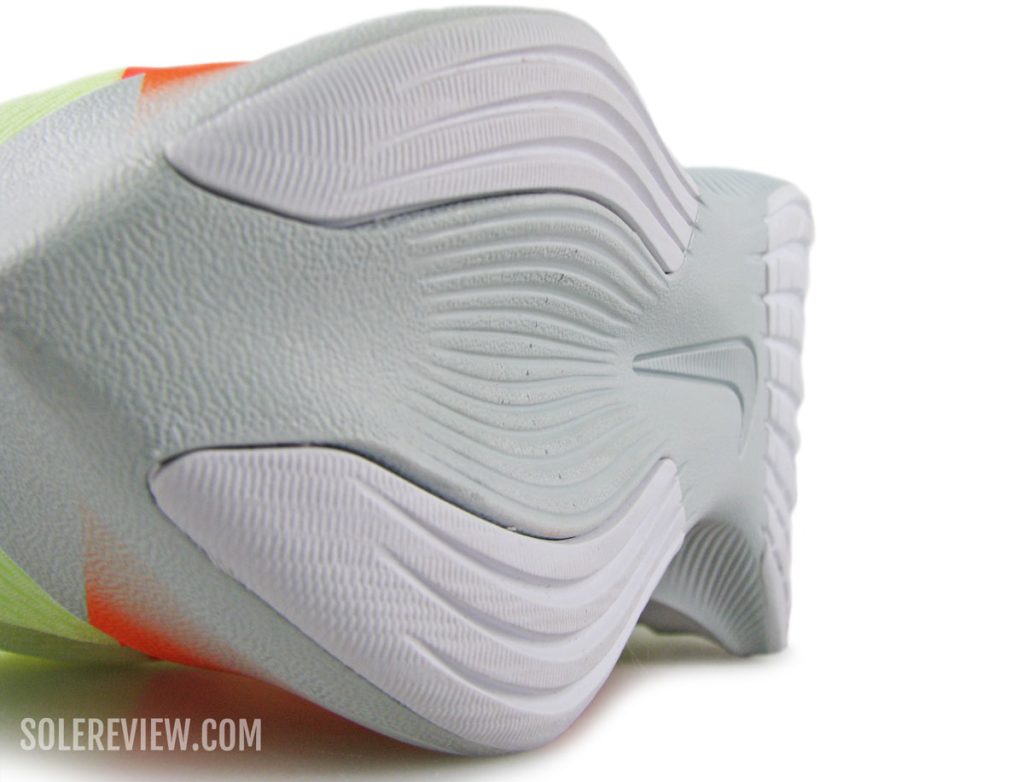
The thicker heel pods re-position the foot over the deeper part of the transition groove, thus increasing the ride softness.
As a result, the foot shifts (forward) to the thickest part of the midsole, and also over the deepest part of the transition groove.
With this minor re-positioning of the foot, the cushioning benefits from a higher stack and deeper negative space under the heel, thus making it softer than the Zoom Fly 3.
The heel has an internal stiffener, so it’s not collapsible.
As the foam pods do all the gripping, the top of the heel collar does not sit flush with the ankle. And that’s okay – the gap has no bearing on the fit quality.
The visible gap above the foam pods may give the impression that the heel isn’t securely fastened, but there’s no need for concern – the foam pods do their job at preventing heel slippage.
Unlike the very reflective Vaporfly, the Zoom Fly 4 does not have any high-visibility elements. The color-blocking details on the midfoot are a nice touch, but they are not reflective.
PROS AND CONS
The Nike Zoom Fly 4 may not be the super shoe that the Vaporfly Next % is, but it has many things going for it. The integration of the Carbon plate and React foam core is seamless; except for the responsive feedback during footstrike, the plate is inconspicuous.
The high-volume midsole is equal parts cushioned and speed-friendly.
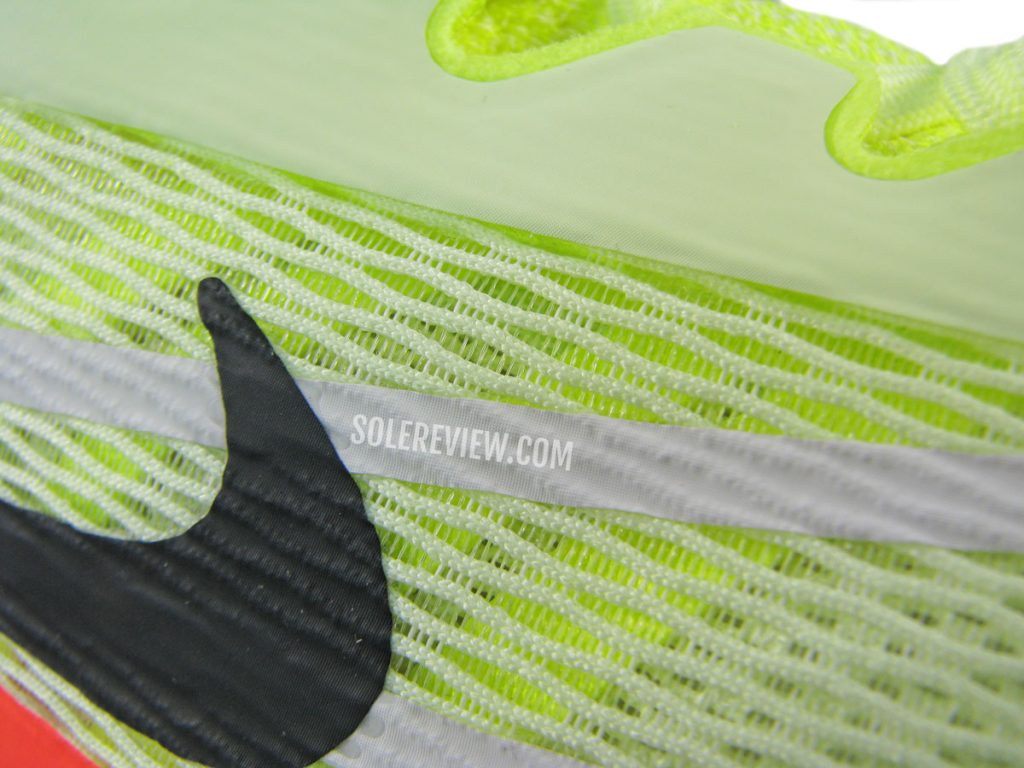
The Zoom Fly 4 no longer uses the synthetic-looking mesh of the Fly 3. In its place is a soft and breathable textile.
That makes the Zoom Fly 4 a versatile trainer-pacer, and all of this comes at a significantly lower cost than the Vaporfly. The upper is snug yet comfortable; the sleeved interior breathes well and grips the foot in smooth comfort without hot spots.
The Zoom Fly 4 isn’t without its share of shortcomings. This shoe is nearly 10-ounces heavy, and offers neither reflectivity nor widths. By now, many readers will know that the React foam turns firmer in freezing temperatures.
Also, the outsole grip isn’t great for a speed trainer – an observation that also applies to the Vaporfly Next %. While the forefoot outsole has decent traction, it lacks the bite of speed shoes like the adidas adios Pro 2, Boston 10, and products from the Asics Meta line-up.
COMPARISON: THE NIKE ZOOM FLY 4 VERSUS THE NIKE VAPORFLY NEXT% V2
Besides the $80 price gap that separates the Zoom Fly 4 from the Vaporfly Next% V2, there are several performance-related differences.
As noted in our review, the Vaporfly’s ZoomX midsole makes it a much softer and lighter running shoe. The characteristic ‘springboard snap’ of the plate is also (more) noticeable; the ZoomX foam gives the Carbon plate a wider range of movement.
The VF Next% is nearly 3-ounces lighter than the Zoom Fly, and that vastly increases the ride comfort during long-distance runs.
The Next %’s upper does a far better job with the airflow due to its generously ventilated mesh, and the reflective logo makes running in the dark a safer experience.
The asymmetrical lacing setup also relives the lacing pressure over the foot. To sum up, the Vaporfly Next% V2 offers a higher level of marathon-level comfort than the Zoom Fly 4.
That said, the Zoom Fly 4 outperforms the Vaporfly Next% V2 in a few areas. The firmer React midsole provides better rearfoot stability and durability – something that’s in short supply on the crease-prone Vaporfly.
SHOES SIMILAR TO THE NIKE ZOOM FLY 4
The Saucony Endorphin Speed V2 is often seen as a direct competitor to the Zoom Fly 4, and that’s for a good reason. Like the Fly 4, the Endorphin Speed has an internal plate inside a cushioned midsole that results in a speed-friendly marathon shoe. Also, both the shoes are priced the same.
However, noteworthy areas of difference – like the Endorphin’s softer PEBA midsole and lighter upper – create a ride and upper character that’s closer to the Vaporfly than the Zoom Fly. From a performance viewpoint, the Saucony Endorphin Speed 2 is a softer (and less supportive) shoe than the Nike Zoom Fly 4.
Comparing the Novablast V2 to the Zoom Fly 4 may seem tangential. However, the Novablast’s Flytefoam midsole offers a high-cushioned ride in a similar heel offset.
Despite the Asics Novablast 2’s lack of an internal plate, the rocker midsole geometry makes quick turnovers happen. Thus, if you’re in the market for a transition-friendly marathon shoe, then the Asics Novablast 2 is a cheaper alternative to the Zoom Fly 4.
There are a couple of adidas shoes that come to mind.
The adidas Takumi Sen 8 has a cushioned and lightweight ride that’s also comfortable enough for long-distance runs. It uses the same midsole material (Lightstrike Pro) as the more expensive adios Pro 2, and inside the foam core are ‘Energy Rods’ that assist with the transition process.
If not the Takumi, the adidas Boston 10 also works as a high-mileage speed shoe; our review can be found here.
Do you own this shoe? Improve this review by sharing your insights – submit a review here.

